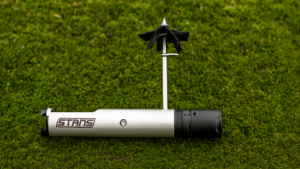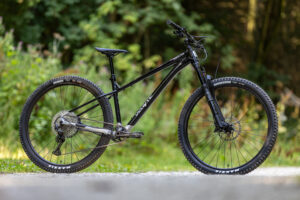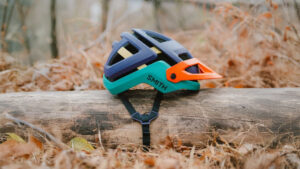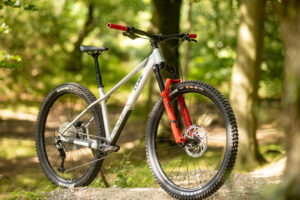Bombing around in the dark may seem like a mad thing to do, but night riding is great! Here's our rundown of the best mountain bike lights as rated by our expert panel of testers.
Technology has developed to the point where the best mountain bike lights are now as bright as most car headlights. Which means more speed, more control and more confidence when riding off-road at night.
We’ve picked handlebar lights, best mountain bike helmet lights and e-bike specific in various price categories. If you want to just focus on helmet lights, check out our guide to the best MTB helmet lights. You’ll probably also want to check out our best mountain bike jackets, best riding pants/trousers guides and of course the tried and tested best mud tyres guide for the ultimate winter set-up.
Best MTB lights – quick list
- Best helmet light – Exposure Zenith
- Best budget helmet light – Sigma Buster 700
- Best handlebar light – Exposure Six Pack
Best mountain bike lights: helmet mount

Superlight and totally faff-free, the Exposure Zenith is our top head unit.
1. Exposure Zenith MK2
Best mountain bike helmet light
Weight: 161g | Max lumens: 2,100 | Rating: 10/10
Reasons to buy:
- Bright
- Sturdy
- Fully programmable
Reasons to avoid:
- Pricey (but worth it)
- Mounting issues with some helmets
Unmistakably from the stable of highly-regarded light brand, Exposure, the Zenith MK2 gets a CNC-machined body housing both the lamp and the battery. The all-in-one unit attaches to a helmet with Exposure’s slick vent mount, which keeps things secure and low-profile to avoid getting caught on low-hanging branches. Most of the time it’s an excellent solution, but we have experienced issues with some helmets using a MIPs liner.
The Zenith MK2 is a bit more powerful than the Joystick or the Diablo, but the flipside is extra weight. On balance we think the extra 20g or so is worth shouldering as you get a bigger battery, which means a longer run time for any given power output. And toggling between modes is particularly simple on the Zenith because you can use Tap mode to knock the power up or down without searching for the button. There are loads of advantages with the Exposure Zenith, but the bottom line is that we could ride faster with this light than any other on test.
Read the full Exposure Zenith MK2 review

The latest Exposure Diablo is brighter and lasts longer than the previous version, although it costs a bit more.
2. Exposure Diablo MK14
All-in-one convenience
Weight: 149g | Max lumens: 2,000 | Rating: 9/10
Reasons to buy:
- Fully customisable
- Low-profile helmet mount
- In-saddle, user-friendly, Tap technology
Reasons to avoid:
- Run time is a little lacking
- Fiddly set-up and somewhat clunky App
Smaller and lighter than the Zenith, the Exposure Diablo is another great off-road option. It shares a similar CNC-machined aluminium case, with the lamp and battery enclosed in the single unit. With no wires to route, or manage, it works a dream mounted to your helmet. Exposure’s through-vent mount is also light, low-profile, and simple, although it can struggle for space on some modern MIPs-lined helmets. Fortunately you can also use a GoPro-style mount, which is something a lot of the latest helmets include as standard.
There are loads of modes, all etched into the light body so you don’t have to check the instructions every time you use it. Better still, you can use Tap mode to cycle through the modes by simply tapping the light while you’re riding along, saving you fumbling around for buttons. There’s also a remote that can be mounted to the bars, and an App you can access via your smartphone. A crisp, white beam and ample power as a secondary light makes the Diablo highly recommended for serious night riding.
Read our full test review of the Exposure Diablo MK12

The Gloworm uses a separate battery and lamp, which has its pros and cons.
3. Gloworm X2 Adventure Lightset
Best value helmet light
Weight: 299g | Max lumens: 2,000 | Rating: 9/10
Reasons to buy:
- Excellent value
- Customisable
- Remote control app
Reasons to avoid:
- Battery life on full beam is low
If you’re happy to forgo the convenience of an all-in-one unit, and run a wired unit with separate battery pack, the advantages are potentially a longer run time and less weight on your head (but more on your back). Of these types, the Gloworm X2 Adventure is our pick of the crop. There’s a twin-LED lamp unit that’s made from CNC-machined alloy, and this is tethered to a two-cell battery. similar in size and build to the Hope R4+, using a twin LED machined alloy head, but combined with a lighter and smaller two-cell battery. There are a couple of helmet mounts in the box, but the GoPro style option is definitely the more secure.
There’s ample power in full beam, but battery life isn’t great, so we’d power the light down to the 1,400 lumen setting to eek out the run time. Or customise your own power mode using the brand’s latest smartphone app. As the lamp unit runs a spot and a flood beam, if you’re planning on running it as a helmet light, we’d also recommend swapping the flood for another spot – there’s a spare in the box. Overall, the lamp unit does sit a little high, but the Gloworm X2 is a great package at a cracking price.
Read the full review of the Gloworm X2 Adventure Lightset

The Sigma Buster 700 shines bright for its performance and value.
4. Sigma Buster 700
Best helmet light under £50
Weight: 148g | Max lumens: 700 | Rating: 9/10
Reasons to buy:
- Great value and good lens light
Reasons to avoid:
- Modest battery life.
If you’re looking for a helmet light that costs less than £50, the Sigma Buster 700 is a great option. The lumen count sounds trifling, but out on the trail it has enough power and a sufficiently focused beam to light up the way ahead. Run time at full power is around 90 mins, which should be enough for most night rides, especially if you power it down (or turn it off) on the climbs.
We were impressed by the helmet mount – the flexible base deforms to the shape of your helmet. It sits a little high, but for the money the Sigma Buster 700 is a great way of getting into night riding without breaking the bank.
Read our full test review of the Sigma Buster 700

For under £100, the Magicshine RN1500 is a great helmet option.
5. Magicshine RN1500
Best helmet light under £100
Weight: 142g | Max lumens: 1,500 | Rating: 8/10
Reasons to buy:
- Lightweight all-in-one unit
- Punchy output
- Optional GoPro mount available
- Common USB-C charging cable
Reasons to avoid:
- Only about an hour run time on full power
- Runs a little hotter than most lights
- Limited programmability
We found a lot to like about the Magicshine RN 1500 mountain bike light. It’s easily mounted, lightweight and charging is user friendly. For a light that weighs just 142g and pumps out 1,500 lumens, it packs a noticeable punch. At this weight it comes with the standard Velcro mount, but if your helmet has a GoPro mount built in, you can purchase an adapter from Magicshine and drop it down to 125g. With this fitting you don’t have to faff around with Velcro straps, and it also reduces the stack height, creating a bit more head clearance.
The RN 1500 runs off a Lithium-Ion battery that’s charged via a common USB-C cable. Run time is only about an hour on full power, but this extends to a claimed 10 hours on the lowest 300 lumen setting. We reckon the best compromise is 750; powerful but you get close to a three-hour burn time – ideal for most night rides.
The on/off switch acts as a fuel gauge, changing colour as you burn through the charge, although it’s not possible to see this when the light is helmet mounted. Our tester found the RN 1500 to be super reliable and consistent, making it a great addition to a regular bar-mounted light for cutting through the gloom.
Read our full review of the Magicshine RN 1500

Typical top build quality marks out the Hope R4+ light, but it’s tall, so watch out for low branches.
6. Hope R4+ LED
Best helmet-mounted light for versatility
Weight: 440g | Max lumens: 1,500 | Rating: 8/10
Reasons to buy:
- Excellent build quality and durability
- One of the best battery run times
- Lighter, 2-cell battery model available
- Produced in the UK
Reasons to avoid:
- Tall height means it sits high on a helmet
- Separate cable-connected battery
- Not the lightest helmet-mounted option
Even though the Hope R4+ has a lamp and separate battery connected via a cable, we tested it in the helmet category because the head unit is compact, and the battery has a better run time than most of the helmet lights we reviewed. Like all Hope products, these lights are produced in its own factory and full spares backup is a given with this brand.
Our test sample R4+ was the standard model with a four-cell Li-Ion battery, but Hope also sells a R4+ ‘lightweight’ with a 2-cell battery. Both options use the ES (Energy Status) fuel gauge, which is button-activated and has five stages, so is easy to read – although not when it’s strapped on the back of your helmet.
The finish and build quality of the Hope R4+ is excellent. It has an even beam pattern and blasts out a lot of light – although it says 2,000 lumens in the spec, the R4+ only has 1,500 lumens on full power. With all the extra clamps in the box it’s a versatile package, although our tester felt a lower profile helmet mount would be advantageous, and also a remote for the fuel gauge just to make better use of the ES technology.
Read our full review of the Hope R4+

Suitable for both helmet or bars, the Knog works well in both applications, but better as a helmet light for off-road use.
7. Knog Blinder 1300 Night Light
Best multi-use helmet/bar light under £100
Weight: 175g | Max lumens: 1,300 | Rating: 8/10
Reasons to buy:
- Compact, all-in-one battery/light
- IP67 waterproof rating
- Premium quality construction
- USB-C rechargeable
Reasons to avoid:
- No charging cable or plug in the package
- Only half the helmet mount is included
Knog’s PWR Mountain Kit light that we tested in 2021 was a modular design with lots of built-in accessories, whereas the Blinder 1300 has the battery and lamp all contained in a single shell with a conventional on/off switch. Knog categorises this as a road light – and our image shows it mounted to a handlebar – so if you want to run it as a helmet light (as we did for the test), then you’ll need to buy an additional mount.
There are five modes pre-programmed into the Blinder 1300 – you get the high, medium and low beam as well as a pulse strobe and eco modes. The latter are road-specific, but handy if you’re limping home on low power. Changing between light modes is done via a push-button on/off switch, which also doubles as a battery life and charge indicator.
Although the Blinder does put out a good pool of light, it has a pretty yellow tinge compared to some top-end brands, and lacks the clarity for picking out detail – if you’re running a more powerful bar light the beam can get a bit overwhelmed. Run time is dependent on the mode, but at just over 75 minutes on high beam it’s a little less than average for a light of this size and class. Dropping the power by half doubles the run time.
Read our full review of the Knog Blinder 1300
Best mountain bike lights: handlebar mount

Exposure makes some of the best all-in-one MTB lights, and the Six Pack is no exception.
1. Exposure Six Pack Sync MK13
Best all-in-one handlebar light
Weight: 389g | Max lumens: 5,450 | Rating: 9/10
Reasons to buy:
- Lamp and battery in a single unit
- Fully customisable
- Superb optical clarity
- Sturdy build quality
Reasons to avoid:
- SYNC App needs work
- It’s upper-end price wide
- All the weight is on the handlebar
Best described as sunshine in a can, the Exposure Six Pack throws out over 5,000 lumens in a package about the size of a drinks can. Being all-in-one means no cables to attach or route along the tubes, and no unsightly velcro straps and battery packs mounted to the frame. The bar mount is also small and discreet, so you can happily leave it attached during the winter months without setting off any OCD.
There are loads of different settings, all etched into the body so you don’t have to remember a random sequence of button presses. There’s an app for tuning the modes and a run time display on the back. Using Reflex ++ mode lets the light automatically adjust output depending on your speed, which is great for maximising battery life on-the-fly. Packed with tech, durable, and boasting one of the best beam patterns out there, the Exposure Six-Pack gets our vote.
Read our full test review of the Exposure Six Pack Sync MK13

The Magicshine Monteer 12000 is extremely bright in full power mode – actually too bright for tight woodland trails, but obviously you can turn it down.
2. Magicshine Monteer 12000
Best bar light for sheer brightness
Weight: 300g (light), 897g (battery) | Max lumens: 12,000 | Rating: 9/10
Reasons to buy:
- Light mode customisable using App
- Incredible light output
Reasons to avoid:
- Tool-free angle adjustment failed on our sample
- Fussy remote mounting
- Heavy battery
- Do you really need this much power?
As the name suggests the Magicshine Monteer 12000 blasts out a staggering 12,000 lumens. That’s more than double the brightest car headlight. The good thing is that you can run the Monteer at a lower power setting and increase the run time.
In fact we’d recommend dropping down to around 3000 lumens in the trees as you get less glare and bounce back. The clamp is a hinged design, so you can attach it without moving the controls, and the fixing bolts are on the top so you can access them easily. You can adjust the angle of the lamp by loosening the small lever on one side – but unfortunately, this broke on our test sample. Ultimately this light is all about power. And as we said in the review “with the Monteer 12000, you can literally ride as hard and as fast at night as you do during the day”.
Read our full test review of the Magicshine Monteer 12000

The Ravemen XR6000 is good value and has a decent beam, but the burn time is a bit stingy.
3. Ravemen XR6000
Best value bar light
Weight: 240g (light), 385g (battery) | Max lumens: 6,000 | Rating: 8/10
Reasons to buy:
- Fast charging
- Two fuel gauges
- Easy-to-use remote switch
- Excellent clamp system
Reasons to avoid:
- Short Burn time on full power
We’ve tested Ravemen lights in the past and been underwhelmed by the power on offer. But this new light is a different proposition altogether. It has a separate light and battery pack with a claimed output of 6000 lumens – plenty enough for off-road use. The alloy lamp unit is sleek and comes with a secure mount that can be positioned centrally over the stem.
We like the fact that it comes with dual fuel gauges, and you can also use the battery to charge a phone, if you need a top up in the middle of nowhere. This beam is quite special in that it’s similar to a modern car headlight. There’s a spotlight that illuminates the distance, and a floodlight to pool around the foreground. But we needed to run all the LEDs to get sufficient light, and this reduced the run time to an hour. So you’ll need to be cautious with power management to make it last a two hour ride.
Read our full test review of the Ravemen XR6000

The Lupine Wilma R7 is a quality product.
4. Lupine Wilma R7
Best for build quality
Weight: 383g | Max lumens: 3,200 | Rating: 10/10
Reasons to buy:
- Portable sunshine
- Customisable
- Versatile mounting
- Excellent quality
Reasons to avoid:
- You pay a premium
- There are brighter lights now
The Lupine Wilma R7 impressed us enough when we tested it to earn a perfect 10/10 rating and a coveted Editor’s Choice badge. Helping it achieve this award is the superb build quality and the perfectly judged beam pattern. It’s stunningly bright but without causing any hotspots, glare, or harsh shadows.
Underlining the thought that has gone into the Wilma’s design is the included remote and comprehensive mounts. It’s also fully customisable in the app and dual fuel gauges and an audible alarm mean you’ll never unexpectedly run out of juice.
Read our full test review of the Lupine Wilma R 7

The Exposure Flex MTB is a neat e-bike light, but the bar clamp might not gel with all stem designs.
5. Exposure Flex MTB
Best e-bike-specific handlebar light
Weight: 100g | Max lumens: 3,200 | Rating: 8/10
Reasons to buy:
- Fantastically well made product
- Reflex technology adjusts power automatically
- Small and light
Reasons to avoid:
- Expensive for just a lamp unit
- We couldn’t centre the lamp unit over our Race Face stem
To make the Flex, Exposure has basically taken the front end of a Diablo, lopped off the back, and wired in a cable so that you can power it off your e-bike battery. That’s no bad thing seeing as the Diablo is one of our top helmet lights, with a crisp, white beam and low overall weight. The total amount of power you get depends on the voltage of your e-bike, but the Flex automatically adjusts this for you.
The Flex is well made and very discreet. You do have to buy an extra cable to run it on your e-bike, but that should set you back less than £15. However, the Flex comes as standard with Reflex technology, so you can let the light power up and down automatically depending on your speed. Which helps conserve battery.
Read our full test review of the Exposure Flex MTB

Gloworm’s XS packs everything into a great value set.
6. Gloworm XS Lightset
Weight: 521g | Max lumens: 2,800 | Rating: 8/10
Best bar-mounted light with a remote switch
Reason to buy:
- Customisable, modular setup
- Spares and tools included
- Gloworm LINK app compatibility
- Handlebar remote included
Reasons to avoid:
- Awkwardly shaped battery is weighty
- Battery mounting strap is too thin
Gloworm has produced a versatile and customisable set up with the XS lightset that means you can tweak everything to suit where and how you ride. It’s sold as a kit (tested here) or you can buy the parts individually, choosing from different battery size options. We felt the XS Lightset offers the best value, and you do get everything in the box, including a handlebar remote which can also be configured to run a second light.
The head unit is not only adjustable to different bar diameters, but you can also bolt on an adapter, allowing you to run it on a helmet. The lamp unit comes with one flood and two spot lenses, but like all Gloworm lights you can customise this setup, and spares and tools are included. Our tester didn’t see the need to tweak this arrangement as it pools a decent amount of light close in, but there’s still plenty of punch down the trail for higher speeds. However, It doesn’t have the raw power of the Exposure Six Pack Mk12 or MagicShine Monteer 12000.
The Gloworm XS is amazing value for money and versatile too. However, our test notes did highlight the battery’s high weight and awkward shape as well as the thin Velcro mounting strap which is way too flimsy.
Read our full review of the Gloworm XS

Light and Motion’s Seca Enduro has a great spread of light.
7. Light And Motion Seca Enduro
Best light with a wide-angled beam
Weight: 424g | Max lumens: 2,500 | Rating: 9/10
Reasons to buy:
- Smooth beam pattern
- Easy to install
- Great visibility, with a wide angled beam
- Useful ‘Race’ mode with two settings
Reasons to avoid:
- A need to cycle through settings
- Long awkward cable
- More padding for battery needed
We’ve tested a version of the Seca Enduro in every light review the last five years and it remains unchanged. And there’s a good reason for that – it’s bright, easy to fit, and due to its custom reflector, it has one of the smoothest beam patterns out there.
The Seca Enduro uses a distinctive oval-shaped four-LED lamp unit and a 6-cell Li-ion battery pack. This pack mounts to the frame using a heavy-duty Velcro strap, which we really like because you can get it super tight. The lamp is easy to fit due to the rubber watch strap attachment, which stretches to fit any handlebar diameter, even 35mm. And there’s a bit of give in it, so the lamp can also be angled up or down without having to get a tool out.
Two off-road light modes are offered, along with a flashing and low beam. Race mode is our tester’s preferred choice as it has two settings: high (2,500 lumens) and medium (1,250 lumens) beams. Other lights here smash the Seca Enduro in terms of lumens, but the beam is high quality – everything looks sharp and focused, there are no dark spots or weird halos and it also has a really wide angle beam.
Read our full review of the Light and Motion Seca Enduro

Magicshine’s MJ-906SE can be run off the internal e-bike battery, or a separate power pack.
8. Magicshine MJ-906SE e-bike light
Best value e-bike light
Weight: 121g | Max lumens: 4,500 | Rating: 10/10
Reasons to buy:
- Cables available for the five main e-bike motor brands
- Waterproof rating of IPX6
- Can also be run with a separate Magicshine Li-ion battery
- Fantastic value
Reasons to avoid:
- Slightly cheaper construction than Exposure or Lupine
- Doesn’t really have the 4,500 lumens claimed
- No compatibility for Fazua or TQ motors
Magicshine now offers compatibility with five leading ‘full-power’ e-bike motor brands, including Giant and Yamaha. It’s a relatively future-proof system too, as it uses a modular (two-piece) cable, so you can move the Magicshine MJ-906SE light from a Bosch to a Shimano motor by just plugging in another cable with a different connector. You can also hook this light up to a conventional Li-ion battery and run it on an analogue bike if you prefer.
The lightweight head unit features twin Luminus SST-40 LEDs, which put out a claimed 4,500 lumens on full beam. There are secondary 2,500 and 1,800 lumen settings and some flashing modes, which you can access during setup. Although the light doesn’t really have the 4,500 lumens claimed, it’s still powerful and bright and the beam quality is good too. Our tester did note that compared to the Exposure Flex and Lupine SL-X e-bike lights, the MJ-906SE has a slightly cheaper plastic construction, which is reflected in its much lower price tag.
When we tested the Magicshine MJ-906SE in 2021 it was an absolute steal at £99, but three years on the price has now increased to £139.99. This doesn’t include a ‘Light Connection Cable’, which costs either £12.99 or £14.99 depending on the motor brand. However, we feel it’s the perfect starter e-bike light for riders on a budget.
Read our full review of the Magicshine MJ-906SE

Lupine SL X is a good upgrade for any e-bike.
9. Lupine SL X e-bike light
Best e-bike light for build quality
Weight: 170g | Max lumens: 1,800 | Rating: 8/10
Reasons to buy:
- Excellent beam pattern
- Superb build quality
- Handlebar-mounted remote
- Now available for five e-bike motor brands
Reasons to avoid:
- Lamp unit fouled our test bike’s stem faceplate
- Sold with an integrated connector for one motor brand
- Expensive
When we tested the Lupine SL X e-bike light in the autumn of 2021 it was only compatible with Bosch, Brose and Shimano motors. Step forward three years and Lupine has upped its game and now this premium light is compatible with the Fazua and TQ motors that are fitted to the best lightweight e-bikes. There’s still no Yamaha/Giant compatible model though.
Lupine lights are some of the best quality units we’ve ever tested, and the SL X is no different. The SL X lamp has a lightweight machined body, with a remote switch and super-minimalist (31.8 or 35mm) bar clamp, allowing you to get it really close to the stem. However, the back of the lamp did contact the faceplate of our test bike’s Race Face stem, so the single clamp could do with being slightly longer.
The lamp unit has a central LED housed inside a massive Fresnel reflector and is surrounded by nine automotive LEDs. These are for riding in daylight and are active all the time, but at any point you can flick on the main light via the bar-mounted remote. You then have high and low beam options. The light is amazingly bright and white, which is perfect for picking out detail and it really feels like you have more than 1,800 lumens on tap.
Read our full review of the Lupine SL X

Cateye’s AMPP 800 is a basic unit, but works well as a starter pack.
10. Cateye AMPP1100/AMPP800 Lightset
Best handlebar and helmet light package
Weight: 222g (AMPP1100), 118g (AMPP800) | Max lumens: 1,100 (AMPP1100), 800 (AMPP800) | Rating: 8/10
Reasons to buy:
- A great value, versatile package
- Sharp and crisp beam patterns
- Charging cable included
- Low profile helmet light
Reasons to avoid:
- Modes aren’t programmable
- Helmet light button is tiny
Although you can buy both of these Cateye lights separately, we tested the set, which sells for £159.99. In the box you get a 1,100 lumen handlebar light and 800 lumen helmet lamp. Both lamps are standalone units and run off integrated, rechargeable Li-Ion batteries. The 800 light comes with a Velcro strap and positional mount with a curved base, the 1100 has an adjustable plastic band clamp.
As its name suggests, the AMPP800 puts out 800 lumens and has a spot beam with a narrow focus, making it perfect for picking out details or fast-approaching corners. The AMPP1100 handlebar light also gets a spot beam, and while we’d normally criticise the lack of spread for a light with only 1,100 lumens, it does light up the trail, albeit in a smaller area. The light beam is blue/white, so everything looks sharp and crisp and the pool of light is very even.
Both lights feature five modes – high, medium, low, long flash and short flash, and while they turn on in the bright setting, neither is programmable, so you will have to cycle through all the modes to get back to high beam. This is more of a pain on the helmet light, since the button is tiny and hard to find with gloves on.
Read our full review of the Cateye AMPP800

Night riding is super fun if you get a group of mates together.
Other mountain bike lights to consider
We tested the bar-mounted Hope R2 LED STD (Standard) light, which uses the two cell ES (energy status) battery pack and although it’s just as bright as the R2 LED Epic – it just won’t last as long. On high beam the R2 will put out about 1,000 lumens of crisp white light for around an hour. The beam pattern is narrow, so illuminates less of the trail, and often we couldn’t see obstacles until we were right on top of them. Unfortunately, as a sole handlebar light the smaller battery doesn’t quite have the staying power to match the L&M Seca Enduro or Magicshine lights we tested.

The NiteRider Lumina Max 2500 is not off-road specific, but does a decent job.
Niterider’s lights have alway featured in our group tests but in recent years competing lights with similar outputs and burn times but lower price tags have scored higher marks. We tested the NiteRider Lumina Max 2500 in 2022, a bar-mounted light with the lamp and battery self-contained – it’s light, easier to fit, and with the option of the NiteLink Wireless Remote. Our tester noted that it’s well made and has some nice touches, but it does feel like a crossover road light rather than a bespoke off-road unit. It’s reasonable value but the limited run times mean it’s a light for shorter rides only.
Another similar looking light from the same brand is the NiteRider Dual 1800, a handlebar-mounted all-in-one unit with two LEDs, kicking out a claimed total of 1800 lumens. This light uses a new Collimator Lens, which helps distribute the light evenly across your field of vision. The light clarity is excellent – it has a wide horizontal beam pattern with no hot spots or dark patches. However, our main criticism is the lack of run time on full power – we got just over half an hour on Boost mode.

The Knog PWR Mountain Kit was a great option, but sadly discontinued.
When it comes to lighting, Knog is renowned for its edgy designs and progressive design ideas. We tested the Knog PWR Mountain Kit light, a modular design that can be mounted in several different ways with the option to add other lamp units to run from the battery. Our test notes revealed that it offered value for money and versatility, but the on-trail performance was lacking. That was back in 2021 however, and it looks like this light package has been discontinued, with Knog now focusing on its compact Blinder range of front lights.

The sun sets on a winter day, but the fun is just starting.
How we tested the best mountain bike lights
To put the lights through their paces we mapped out a 20-minute test loop with a long technical climb and long descent with some tech at the top and fast bridleway at the bottom and did repeat loops on a Whyte G-170. This mixed terrain allowed us to play around with the light’s built-in modes, toggling down to dimmer settings when riding slowly and up to full power for the descent and that final sprint.
Managing output in this way extends battery life, but we haven’t printed run times because they don’t always discharge at a constant rate. They’re also affected by things like temperature (and age) – on a cold night, your battery just won’t last as long.
We used the e-bike lights on a Bosch-equipped Whyte E-180 e-bike. For purposes of convenience we routed the lights externally, even though the optimum is to place the cable inside the frame.

Lower power means less bounce-back in the trees
What to look out for in the best mountain bike lights
As the evenings draw in it might seam like opportunities for a mid-week blast are fading with the light, but night riding is not only a great way to extend your riding season; it’s brilliant fun too. Blasting around the woods at night brings new life to familiar trails, sharpens your skills and hones your fitness. And it’s a good excuse to get warmed up with a pint in the local pub afterwards.
To get the best experience possible, a good set of lights is essential. Fortunately there’s a vast array of options on the market at a range of price points to suit most budgets. Once you’ve decided how much you’re going to spend, the next decision to make is whether to run one big powerful light or spread your output between a helmet light and a bar light.

When you’re out on the moors you want all the light you can get
The latter are going to be more versatile, but it’s important to match the brightness and run times of the two lights, and a lot depends on the type of terrain you’re riding – for example, you can easily use a single bar-mounted light with about 1,500 lumens if you’re riding big wide gravel roads. If you’re ducking off into the trees and riding harder and faster on technical singletrack, we’d advise doubling the output or adding that secondary helmet-mounted light.
Splitting the light between your bar and helmet is always a good idea because the low-mounted bar light creates shadows and texture, allowing you to read the trail, while the high helmet light allows you to scan for obstacles, illuminate around turns and see what you’re doing off the bike.
How the lights are packaged is also important – there are two basic set-ups. Integrated systems, where the battery and lamp are contained in a single unit, and two- piece systems, where you have a lamp unit and a separate battery, connected via a cable.
Either type can be mounted on the bar or helmet but obviously using a two-piece system up top does mean you’ll have a cable running down the back of your helmet.

We add photos of all the beam patterns so you can compare and contrast relative light output.
Power
Lumen is a measurement of light output – the higher the number the brighter the light. Some manufacturers quote measured lumens, which is a truer reflection of the actual light output.
Most lights also have several settings (high, low, medium beam), but also a secondary mode with lower or different options – these are often accessed when you turn the light on. Some lights are also programmable using an app or via sequencing built into the On switch.

A powerful light on your bars combined with a decent light on your helmet is the ideal combo
Helmet mounting
Some bar lights can be attached to a helmet mount, which is usually plastic and held in place with two Velcro straps that loop through the vents. There are also dedicated helmet lights using a similar system, and some manufacturers, like Exposure and Knog, employ a clamp that bolts through a single vent.

Rubber straps are convenient but can stretch and tear over time
Bar mounting
An O-ring is the easiest attachment because it can be removed quickly, expands to accommodate different diameter bars, including 35mm, and the lamp can be angled up or down easily.
Clamp-on mounts (aluminium or plastic) are better for heavy lights because they’re more secure. Most are 35mm with optional shims for 31.8mm bars, although some are size specific.
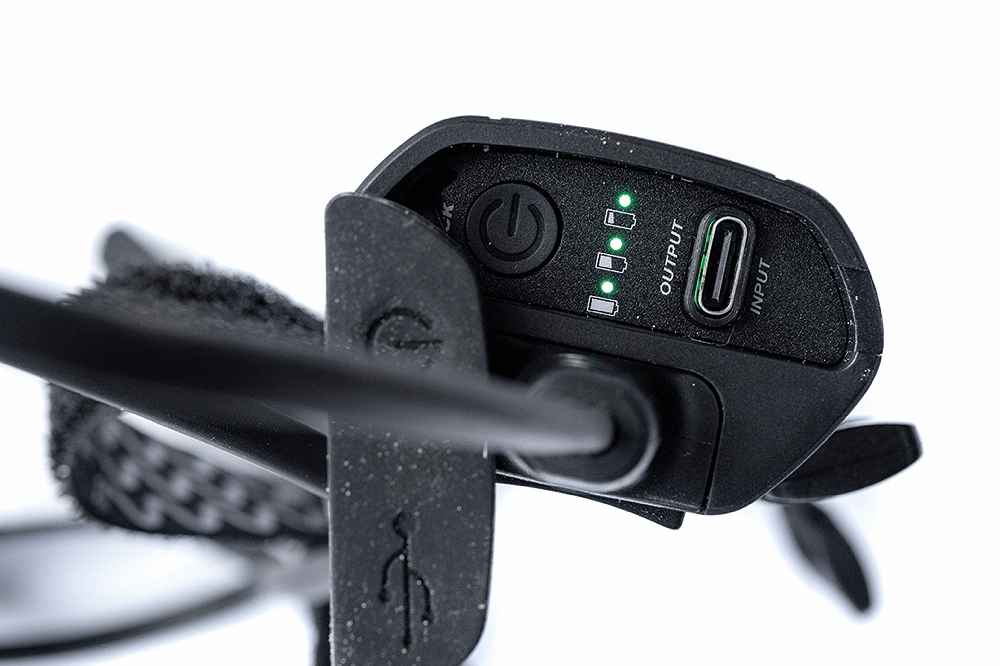
A fuel gauge is handy for checking battery life
Fuel gauge
A fuel gauge is essential for showing remaining power. The simplest are just flashing LEDs (green for good, red for bad) but some of the best use a read-out or percentage countdown displayed on the back of the light.

Getting set up before dark is a good idea; better still is Lupine’s clever app
Remote
With the controls at your fingertips, you don’t have to reach up to toggle the light on or off and you’re also more likely to use the different power levels and preserve battery life.

Cable management can be a nightmare with some lights.
Cable
The most versatile option is to have a short cable to which you can add an extension. Use the short cable when the light is on the bar and battery is on top tube, and then plug in a longer extension when running the light on a helmet/backpack.

We shot the beam patterns of all the lights tested, so you can compare power and spread
Beam pattern
We’ve included pictures of all the beam patterns in each of the specific in-depth reviews. to show what the light looks like on the trail. Click through to those if you want to see how they compare. Ideally you want soft transitions and edges and a pool around the front wheel for picking your way through technical terrain. If there are hot spots, or hard edges to the beam, these can be distracting, making it more difficult to use peripheral vision when riding.

Using your e-bike’s battery to power your lights increases run-time and can save the weight of an extra battery, but does involve routing cables
E-bike specific lights
If you just ride an e-bike, it makes a lot of sense to buy a dedicated light, because the battery in your e-bike is typically 10 times more powerful than the one used to power a bike light. Also, most motors have a built-in port or extra connector, where you can plug a light straight in.
You may need to activate the software, so the bike recognises the light, but an approved dealer can do that for you in about five minutes.

Easy connection straight to your bike’s motor
However, there are a couple of things to bear in mind before taking the plunge. Some lights are not compatible with older e-bikes, and this is because they run on a different voltage. And if they do work, they’re likely to run at a reduced output.

Primed and ready to trail blaze
The other thing to be aware of when running a light is that it will reduce the run time of your bike, anywhere between 4% and 10%. This is because e-bike lights are covered by an EU directive that requires the bike to have a certain amount of residual charge for emergencies.
Obviously, we’re not in the EU anymore, but e-bikes may come into the UK configured this way and it may also come with the light functionality turned off. That’s something a manufacturer may choose to do when it’s building the bike, although we’ve been told it can be reactivated for certain brands. Also, if an electrical product is modified beyond a certain level it no longer complies to EMC testing, which has implications for your warranty.
Our advice is to always check with the bike manufacturer before purchasing an e-bike light to see if it’s compatible, and if there are any issues regarding your warranty. We’d also check light compatibility – most light manufacturers have a chart on their website.









